|
|
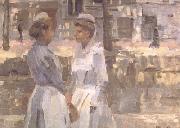 |
Isaac Israels
|
|
Dutch, 1865-1934
Son of Jozef Israëls. He was largely self-taught, showing precocious talent and attending the Academie in The Hague in 1878-80. His first paintings date from 1880-84 and include a self-portrait, portraits of women and military subjects such as Bugle Practice. They were composed in the studio in a precise style, soft grey and brown tones predominating, showing the influence of the Hague school. In 1887 Israels moved to Amsterdam, where he was at the centre of the Tachtigers of writers and painters. Among his friends were George Hendrik Breitner, Lodewijk van Dyssel, Frans Erens, Max Liebermann, Jan Pieter Veth and Jan Voerman. In Amsterdam, after a brief and abortive period at the Rijksacademie, he sought a more fluent technique with which to record contemporary life. His drawings and watercolours are predominantly of cafes, cabarets, dance halls and the street life of Amsterdam. In 1889 he visited Paris, where he met St phane Mallarm, Berthe Morisot, Odilon Redon and Emile Zola. In 1894 he painted Three Servant Girls, the first of his plein-air pictures. From then on he applied transparent colours to capture the fleeting effects of light in oil, watercolour and pastel. His oils were painted in flat broad strokes. For the rest of his life he employed his very personal Impressionist style, which emphasized the interplay of light, colour, line and movement. His favourite subjects were beach, street and park scenes |
|
|
|
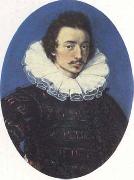 |
Isaac Oliver
|
|
French-born English Miniaturist, ca.1560-1617
was a French-born English portrait miniature painter. Born in Rouen, he moved to London in 1568 with his Huguenot parents Peter and Epiphany Oliver to escape the Wars of Religion in France. He then studied miniature painting under Nicholas Hilliard; and developed a naturalistic style, which was largely influenced by Italian and Flemish art. He later married Sara, daughter of the well-known portrait painter Marcus Gheeraerts the Elder (c. 1520 ?C c. 1590) and his wife Susannah de Critz in 1602 after his first wife, Elizabeth, had died in 1599 ?C the mother of his eldest child: Peter Oliver, who was also a famous "limner". Susannah was the daughter of Troilus de Critz, a goldsmith from Antwerp, and close relative of John de Critz, the Queen's Serjeant-Painter. She was also the older sister or cousin of Magdalen de Critz who married Marcus Gheeraerts the Younger (1562 ?C 1635). After the death of Elizabeth I, he became a painter of James I's court, |
|
|
|
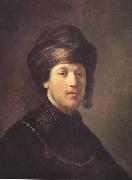 |
Isack jouderville
|
|
c,1612-before 1648
Dutch painter. His father, who came from Metz, kept a popular inn at Leiden. Isack Jouderville was among Rembrandt's earliest pupils and was apprenticed to the artist from late 1629 until the end of 1631. for the payment of his apprenticeship fees, signed by Rembrandt. During his last year of apprenticeship, Jouderville went to Amsterdam with Rembrandt. In 1632 he enrolled as a student of philosophy at Leiden University; it may well be, however, that he stayed in Amsterdam to assist Rembrandt in his workshop with his numerous portrait commissions. Jouderville himself painted mainly Rembrandtesque heads or 'tronies' and was such a faithful follower of his master's early work that several of his paintings were at one time attributed to Rembrandt. In 1636 Jouderville married Maria Le Fevre and settled in Leiden. Between 1641 and 1643 he lived in Deventer, after which he moved to Amsterdam, where he was last recorded in 1645. |
|
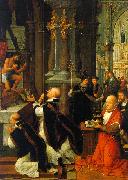 |
Isenbrandt, Adriaen
|
|
Flemish Northern Renaissance Painter, ca.1500-1551
South Netherlandish painter. He became a master in the Bruges Guild of St Luke in 1510, at which time the records specify that he was a 'stranger' and childless. Shortly afterwards he married Maria Grandeel, who bore him one child (d 1512). After his wife's death in 1537, Isenbrandt married Clementine de Haerne, with whom he had three daughters. One further daughter was born through an extra-marital relationship with the innkeeper Katelijne van Brandenburch. According to contemporary sources, Isenbrandt was famous and well-to-do. He held important posts in the Bruges Guild of Sculptors and Saddlemakers, serving as deacon nine times between 1518 and 1538 and as governor twice (1526-7 and 1537-8). |
|
|
|
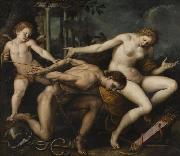 |
Isidoro Bianchi
|
|
Isidoro Bianchi called da Campione (20 July 1581, Campione d'Italia, Lombardy - 5 December 1662) was an Italian painter of the Baroque period.
He was born in Campione d'Italia, Lombardy and was active c. 1626. He studied under Pietro Francesco Mazzuchelli. He excelled in fresco painting for the Basilica of Sant'Ambrogio at Milan and in different churches at Como. The Duke of Savoy chose him to finish a grand saloon at Rivoli, which had been left unfinished at the death of Mazzuchelli, who had commenced it. Bianchi was afterwards made painter to the Court, and was knighted in 1631. |
|
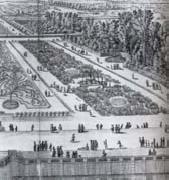 |
Israel Silvestre
|
|
French Baroque Era Engraver, 1621-1691,called the Younger to distinguish him from his father, was a prolific French draftsman, etcher and print dealer who specialized in topographical views and perspectives of famous buildings. Orphaned at an early age, he was taken in by his uncle in Paris, Israel Henriet, an etcher and printseller, and friend of Callot. Between 1630 and 1650 Silvestre travelled widely in France and Italy, which he visited three times, and later worked up his sketches as etchings, which were sold singly and in series. His work, especially of Venetian subjects published in the 1660s, influenced eighteenth-century painters of vedute such as Luca Carlevaris and Canaletto, who adapted his compositions. In 1661 he inherited the stock of plates of his uncle, the printseller Israel Henriet, among which was a large part of the works of Jacques Callot, and many of those of Stefano della Bella. In 1662 he was appointed dessinateur et graveur du Roi and in 1673 he was appointed drawing-master to Louis, le Grand Dauphin. From 1668 he was granted workshop space in the galleries of the Louvre, where the practice of housing eminent artists and craftsmen was a tradition that was originated under Henri IV. Silvestre's atelier was large: he had at least two pupils who had careers as engravers, Franqois Noblesse and Meunier, and In 1670 Charles Le Brun recommended him for membership in the Acadeemie royale de peinture et de sculpture. In 1675 his son, the artist Louis Silvestre, was born at Sceaux. |
|
|
|
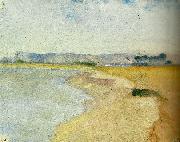 |
ivan agueli
|
|
Ivan Agueli (ursprungligen John Gustaf Agelii tog sig senare i livet namnet Abd Al-Hadi Aqhili), född 24 maj 1869 i Sala, Västmanlands län, död i en tågolycka den 1 oktober 1917 i Barcelona, Katalonien, Spanien, var en svensk målare, religionsfilosof och orientalist. Agueli blev med sitt nydanande måleri en av den svenska konstens förgrundsgestalter. Enbart genom noggrant avvägda färgtoner framkallade han en känsla av avstånd och ljus i sina målningar, som trots det intima formatet äger en stor monumentalitet.
Agueli hade en tämligen välbärgad uppväxt. Hans far, stallmästaren och veterinären Johan Gabriel Agelii (f.1821 i Farstorp, Kristianstads län - d. 22 december 1896)² var dock en sträng man vars relation till sonen skulle bli dålig hela livet. Modern Anna Stina Nyberg (f.1838 i Vika, Kopparbergs län) var en varm människa som kompenserade det kärlekslösa förhållandet till fadern. Efter flera misslyckade försök till studier under åren 1879-1886 i Sala, Västerås, Falun och Stockholm, sändes Agueli till Visby av fadern 1886. Han blev där uppmärksammad för sin konstnärlighet, och började umgås med Richard Bergh och Karl Nordström. |
|
|
|
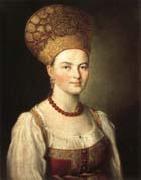 |
Ivan Argunov
|
|
Russian Rococo Era Painter , 1727/1729-1802
Russian painter and teacher. He came from a family of serfs, belonging to the Counts Sheremetev, that produced several painters and architects. In about 1746-7 he was a pupil of Georg Christoph Grooth (1716-49), who painted portraits of the Sheremetev family. With Grooth, Argunov worked on the decoration of the court church at Tsarskoye Selo (now Pushkin). A full-length icon of St John of Damascus (1749; Pushkin, Pal.-Mus.), in Rococo style, is distinguished by its secular, decorative character. The Dying Cleopatra (1750; Moscow, Tret'yakov Gal.) is typical of Rococo decorative painting of the mid-18th century, with its striking combination of light, soft tones. Argunov subsequently painted in a quite different style, mainly producing portraits, of which about 60 are known. Among the first of these are pendant portraits of Ivan Lobanov-Rostovsky and his wife (1750 and 1754; St Petersburg, Rus. Mus.), in which the sitters are idealized, as in ceremonial court portraits. |
|
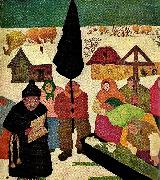 |
ivan generalic
|
|
Ivan Generalic (December 21, 1914--November 27, 1992) was a Croatian naive art painter.
Generalic was born in Hlebine near Koprivnica. In elementary school, painting lessons were his greatest joy and as a child he used to earn money. He mostly drew with pencil on paper bags and some of these sketches were seen by Krsto Hegedusic, at the time (1930) just a student of the art academy, later a professor. Hegedusic was impressed with Generalic's work and organized Generalic's first public art exhibition, held in 1931 in the Zagreb Art pavilion. Positive critiques and contacts at the time led to a new era of not only Croatian, but also world art as well.
After World War II, in 1945 he became a member of ULUH (society of Croatian artists). In 1953 he exhibited in Paris, where he lived and painted for a few months. In 1959 he painted The Deer Wedding - his most valuable work, according to followers of the Croatian naïve art world. |
|
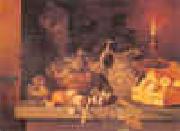 |
Ivan Khrutsky
|
|
1810-1885 Russian Ivan Khrutsky Gallery was a Russian-Polish painter known by his still-lives and portraits. He was born Ivan Fomich Khrutsky into a family descended from Polish gentry in the village of Ula, Vitebsk Gubernia (currently Belarus). In 1827, Khrutsky came to St. Petersburg and in 1830 entered the Imperial Academy of Arts. His first known works are dated 1832. The paintings gradually gathered public and critical acclaim. Khrutsky also worked as an interior designer, and became a popular amongst the wealthy home owners. In 1836, Khrutsky was awarded the Major Silver medal of the Academy for his still-lifes. Khrutsky also executed nice genre pictures and portraits. Old Woman Knitting a Sock, brought him the Minor Gold medal of the Academy. In 1839 he was awarded the title of the Academician. After his father??s death in 1840 Khrutsky left St. Petersburg forever and settled in the family estate Zakharenichi (Zacharniczy), Polotsk region. This period was one of commissioned religious art, mostly from Lithuania. Besides religious paintings he also worked on portraits, such as I.I. Glazunov's, Joseph Semashko's, Mikolaj Malinowski's and others. He died in 1885. |
|
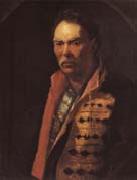 |
Ivan Nikitin
|
|
Russian Painter, ca.1680-1742,Russian painter. The son of a Moscow priest who was close to the imperial court, Nikitin probably studied at the workshop of the Armoury Palace in Moscow and subsequently worked chiefly in St Petersburg. His early portraits were of Peter the Great and members of Peter family, for example the portraits of Peter daughters Elizabeth (St Petersburg, Rus. Mus.) and Anne (Moscow, Tret yakov Gal.) and of his sister Natal ya Alekseyevna (St Petersburg, Rus. Mus.). One of the few signed and dated works is a portrait of Praskov ya Ioannovna, Daughter of Tsar Ivan V (1714; St Petersburg, Rus. Mus.). Nikitin style was formed at the time of Peter the Great reforms of the administrative and education system in Russia, and he ranks as a pioneer of a new style in Russian painting. In his early works, up to 1716, he adapted the medieval Russian style of portraiture to the forms of contemporary European examples. |
|
|
|
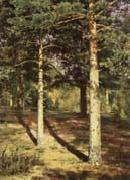 |
Ivan Shishkin
|
|
Russian Painter, 1832-1898
was a Russian landscape painter closely associated with the Peredvizhniki movement. Shishkin was born in the town of Elabuga of Vyatka Governorate (today Republic of Tatarstan), and graduated from the Kazan gymnasium. He then studied at the Moscow School of Painting, Sculpture and Architecture for 4 years, then attended the Saint Petersburg Imperial Academy of Arts from 1856 to 1860, graduating with the highest honors and a gold medal. He received the Imperial scholarship for his further studies in Europe. Five years later Shishkin became a member of the Imperial Academy in St. Petersburg and was professor of painting from 1873 to 1898. At the same time, Shishkin headed the landscape painting class at the Higher Art School in St. Petersburg. For some time, Shishkin lived and worked in Switzerland and Germany on scholarship from the St. Petersburg Imperial Academy of Arts. On his return to Saint Petersburg, he became a member of the Circle of the Itinerants and of the Society of Russian Watercolorists. He also took part in exhibitions at the Academy of Arts, |
|
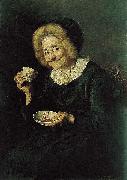 |
Ivana Kobilca
|
|
Ivana Kobilca (20 December 1861 - 4 December 1926) was a Slovene realist painter who lived, worked and studied in various European cities including Vienna, Sarajevo, Berlin, Paris and Munich. She was a member of Societe Nationale des Beaux Arts in Paris. Many of her paintings are still lifes, portraits or country settings. She later tended toward impressionism.
Her best known paintings are Kofetarica (Coffeemadam), 1888; Citrarica (The Zitherist), Likarice (Women Ironers), 1891; Holandsko dekle (A Dutch Girl), Portret sestre Fani (Portrait of Sister Fani), 1889; and Poletje (Summer), 1889. |
|
|
|
|
|
|
|
|
|
|
|
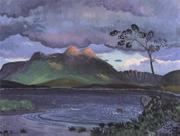 |
James Dickson Innes
|
|
A British landscape painter who specialized in mountain scenes
Welsh Painter, 1887-1914
was a Welsh landscape painter who worked in both oils and water-colours. He was born in Llanelli, his father being a Scotsman who had found employment at the local tinplate works. He was educated at Christ College, Brecon, Carmarthen School of Art, and the Slade School of Art. He was a member of the Camden Town Group.[1] In 1911 he spent some time painting with Augustus John in North Wales, but much of his work was done overseas, mainly in France and Spain, foreign travel having been prescribed after he was diagnosed with tuberculosis. |
|
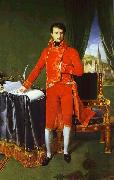 |
Jean Auguste Dominique Ingres
|
|
J. A. D. Ingres (1780-1867)
was born in Montauban on August 29, 1780, the son of an unsuccessful sculptor and painter. French painter. He was the last grand champion of the French classical tradition of history painting. He was traditionally presented as the opposing force to Delacroix in the early 19th-century confrontation of Neo-classicism and Romanticism, but subsequent assessment has shown the degree to which Ingres, like Neo-classicism, is a manifestation of the Romantic spirit permeating the age. The chronology of Ingres's work is complicated by his obsessive perfectionism, which resulted in multiple versions of a subject and revisions of the original. For this reason, all works cited in this article are identified by catalogue. |
|
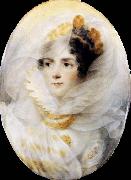 |
Jean Baptiste Isabey
|
|
French Painter, 1767-1855, Painter, draughtsman and printmaker. He trained in Nancy with Jean Girardet (d 1778) and then with Jean-Baptiste-Charles Claudot (1733-1805), master of the miniaturist Jean-Baptiste Augustin. In 1785 he went to Paris, where he began by painting snuff-boxes. In 1786 he received lessons from the painter Francois Dumont, who had also studied with Girardet in Nancy, before entering the studio of David. Although he had received aristocratic commissions before the Revolution to paint portrait miniatures of the Duc d'Angouleme and Duc de Berry and through them of Marie-Antoinette, he did not suffer in the political upheavals that followed. He executed 228 portraits of deputies for a work on the Assemblee Legislative and from 1793 exhibited miniatures and drawings in the Salon. Success came to him in 1794 with two drawings in the 'maniere noire', The Departure and The Return. This type of drawing, using pencil and the stump to simulate engraving, was very fashionable in the last years of the 18th century and reached its peak with Isabey's The Boat |
|
|
|
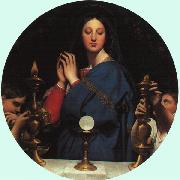 |
Jean-Auguste Dominique Ingres
|
|
French Neoclassical Painter, 1780-1867
was a French Neoclassical painter. Although he considered himself a painter of history in the tradition of Nicolas Poussin and Jacques-Louis David, by the end of his life it was Ingres' portraits, both painted and drawn, that were recognized as his greatest legacy.
A man profoundly respectful of the past, he assumed the role of a guardian of academic orthodoxy against the ascendant Romantic style represented by his nemesis Eug??ne Delacroix. His exemplars, he once explained, were "the great masters which flourished in that century of glorious memory when Raphael set the eternal and incontestable bounds of the sublime in art ... I am thus a conservator of good doctrine, and not an innovator." Nevertheless, modern opinion has tended to regard Ingres and the other Neoclassicists of his era as embodying the Romantic spirit of his time, while his expressive distortions of form and space make him an important precursor of modern art.. |
|
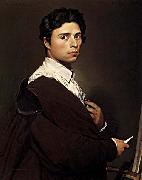 |
Jean-Auguste-Dominique Ingres
|
|
1780-1867
French painter. He was the last grand champion of the French classical tradition of history painting. He was traditionally presented as the opposing force to Delacroix in the early 19th-century confrontation of Neo-classicism and Romanticism, but subsequent assessment has shown the degree to which Ingres, like Neo-classicism, is a manifestation of the Romantic spirit permeating the age. The chronology of Ingres's work is complicated by his obsessive perfectionism, which resulted in multiple versions of a subject and revisions of the original. |
|
|
|
|
|
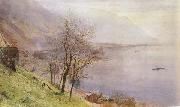 |
John William Inchbold
|
|
1830-1888
English painter. He spent his early years in Leeds, where his father was a newspaper proprietor, but came to London around 1846 to study lithography in the firm of Day & Haghe. His obituary in The Athenaeum records that he went on to study at the Royal Academy Schools, but his name does not appear in the registers. He exhibited watercolours at the Society of British Artists in 1849 and 1850 and at the Royal Academy in 1851. At this period his work has a fluidity and a freedom of handling that is closer to Richard Parkes Bonington than to the prevailing style of Victorian watercolours. Around 1852 he came under the influence of the Pre-Raphaelite movement and radically altered his style. His oil painting of the Chapel, Bolton (exh. RA 1853; Northampton, Cent. Mus. & A.G.) is a meticulously rendered view of the abbey ruins in the Pre-Raphaelite manner. This was followed the next year by At Bolton (Leeds, C.A.G.), another view of Bolton Abbey, this time with a deer prominent in the foreground. Both paintings illustrate lines from William Wordsworth's poem 'The White Doe of Ryleston'. Wordsworth was also the inspiration for the small painting Study in March |
|
|
|
 |
Jozef Israels
|
|
1824-1911
Dutch
Jozef Israels Gallery
Israels has often been compared to Jean-François Millet. As artists, even more than as painters in the strict sense of the word, they both, in fact, saw in the life of the poor and humble a motive for expressing with peculiar intensity their wide human sympathy; but Millet was the poet of placid rural life, while in almost all Israels' pictures there is some piercing note of woe. Edmond Duranty said of them that they were painted with gloom and suffering.
He began with historical and dramatic subjects in the romantic style of the day. By chance, after an illness, he went to recruit his strength at the fishing-town of Zandvoort near Haarlem, and there he was struck by the daily tragedy of life. Thenceforth he was possessed by a new vein of artistic expression, sincerely realistic, full of emotion and pity.
Among his more important subsequent works are The Zandvoort Fisherman (in the Amsterdam gallery), The Silent House (which gained a gold medal at the Brussels Salon, 1858) and Village Poor (a prize at Manchester).
In 1862 he achieved great success in London with his Shipwrecked, purchased by Mr Young, and The Cradle, two pictures that the Athenaeum magazine described as the most touching pictures of the exhibition. |
|
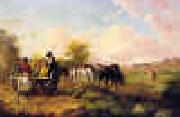 |
Julius Caesar Ibbetson
|
|
1759-1817
British
In 1785, Ibbetson began exhibiting at the Royal Academy with View of North Fleet. Mitchell calls George Biggin (1783), which is one of Ibbetson's earliest known works, "an accomplished full-length portrait in the Gainsborough tradition, [which] should be considered as a milestone in the development of an artist who was entirely self-taught". Through the efforts of Captain William Baillie in 1787, Ibbetson was made draughtsman to Colonel Charles Cathcart on the first British embassy to Peking (Beijing); he made many watercolor drawings of the animals and plants on the journey. While he was away, his Ascent of George Biggin, esq. from St. George's Fields, June 29th 1785 was exhibited at the Royal Academy to great critical and popular acclaim.
In 1789, Ibbetson went to visit the Viscount Mountstuart at Cardiff Castle in Wales. He spent decades drawing the scenery there and, according to Mitchell, "[h]is detailed watercolours of iron furnaces, coal staithes, and copper mines foreshadow the work of Joseph Wright of Derby and J. M. W. Turner and constitute an important record of the early industrial developments in that region, but are less well known than his more numerous scenes of folk life and picturesque scenery." After a visit to the Isle of Wight in 1790, he began painting shipwrecks and smugglers. David Murray, 2nd Earl of Mansfield, and his wife commissioned Ibbetson to decorate Kenwood House, in 1794. This distracted him from the death of his wife and caring for their three children. Her death had "provoked a minor nervous breakdown, exacerbated by near destitution", but the Kenwood project relieved that stress. Four years later, he moved to Liverpool to work for Thomas Vernon. In 1801 he married his second wife, Bella Thompson, and moved to Ambleside.
Ibbetson acquired several generous patrons in Liverpool and in Edinburgh: William Roscoe, Sir Henry Nelthorpe, and the Countess of Balcarress. The last prompted him to write and publish his instruction manual An Accidence, or Gamut, of Painting in Oil (1803). In 1803, he met the Yorkshire philanthropist William Danby and in 1805 moved to Masham to be near him. The next 14 years of his life were the most settled of his life.
Ibbetson died on 13 October 1817 and was buried in the churchyard of St Mary's, Masham.
Benjamin West described Ibbetson as the "Berchem of England" in recognition of his debt to the Dutch 17th century landscape painters. According to Mitchell, "[h]is watercolours are prized for their delicacy and sureness of line". Many were engraved for projects such as John Church's A Cabinet of Quadrupeds and John Boydell's Shakespeare Gallery. |
|
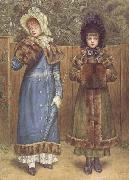 |
Kate Greenaway,RWS,RI
|
|
1846-1901
English painter, illustrator and writer. The daughter of a Fleet Street wood-engraver, John Greenaway (1818-90), she trained at Islington School of Art, Heatherleys Academy and the Slade School of Fine Art, all in London. In 1868 she did her first commercial work, producing Christmas and Valentine cards for Marcus Ward, Belfast. |
|
|
|
|
|
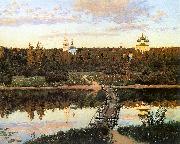 |
Levitan, Isaak
|
|
Russian Painter, 1860-1900
Russian painter of Lithuanian birth. He largely painted landscapes (including pastel sketches), which are noted for their emotive or symbolic resonance. His 'landscapes of mood' had a profound influence on Russian landscape painting, to which he introduced a sense of the unity of humankind and nature, and of the spiritual power of the Russian |
|
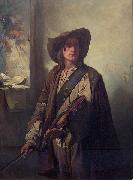 |
Louis Gallait
|
|
(9 or 10 May 1810 - 20 November 1887) was a Belgian painter. His d his reputation especially with the large painting of Charles V's abdication. Gallait's works were considered as the basis for a desirable renewal of historical paintings because of the realism, costume faithfulness and colorful posture of his paintings. His last artwork was sent on tour in Germany and that led to new signals even among German historians. He was also a distinguished portrait painter.
Gallait died in Brussels in 1887. There is a painting by Louis Gallait at the Norton Art Museum in West Palm Beach, Florida ("Art and Liberty").
|
|
|
|
|
|
|
|
|
|
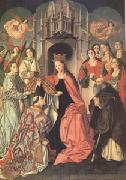 |
Master of ST Ildefonso
|
|
Castile,end of the fifteenth century
Spanish painter. He is named from St Ildefonso's Reception of a Chasuble from the Virgin Mary (Paris, Louvre), which is traditionally held to come from Valladolid; it may even have come from the chapel of S Ildefonso in the Colegiata there. The style, characterized by harmony of colour and intense expressions, resembles that of four panels of St Athanasius, St Louis of Toulouse, both enthroned, SS Peter and Paul and SS Andrew and James the Great, which probably came from the convent of La Merced, Valladolid. They have been attributed to the Master of vila, but Post considered them to be the work of the Master of St Ildefonso, a more sophisticated painter, although both artists modified the harshness of their Netherlandish models. There are also similarities with Jacomart's triptych of St Anne in the Colegiata, Jetiva, but these may be coincidental. Other works attributed to the Master include St Anne and St Anthony of Padua, |
|
|
|
|
|
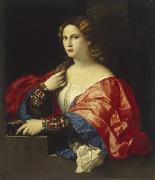 |
Palma il Vecchio
|
|
(c. 1480 - July 1528), born Jacopo Palma or known as Jacopo Negretti, was an Italian painter of the Venetian school born at Serina Alta near Bergamo. He is called Palma Vecchio in English ("Old Palma" - in Italian Palma il Vecchio) to distinguish him from Palma Giovane, his great-nephew.
When Palma arrived in Venice early in the 16th century, he reputedly was a companion and competitor of Lorenzo Lotto, and to some extent a pupil of Titian. He may also have taught Bonifazio Pitati and influenced Giovanni Busi. Palma's earlier works betray the influence of the Bellini. |
|
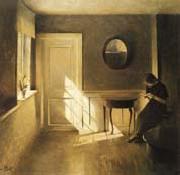 |
Peter ilsted
|
|
1861-1933,was a leading Danish artist and printmaker. Ilsted, Carl Holsoe and Ilstedes brother-in-law, Vilhelm Hammershoi, were the leading artists in early 20th century Denmark. All three artists were members of The Free Exhibition, a progressive art society created around 1890. They are famous for painting images of "Sunshine and Silent Rooms", all in subtle colors. Their works reflects the orderliness of a tranquil life EC- similar to the earlier works of Vermeer. Their art was later referred to as the Copenhagen Interior School. These interiors evoke at once a sense of calm, as well as a sense of mystery. The orderly room are often viewed from behind -- causing one to wonder if the scenes are really tranquil or something else. James McNeill Whistler, Duret and important art critics were early admirers and collectors of Ilsted's work. Ilsted was Hammershoi's brother-in-law. While at first glance their work appears similar, it is in fact quite different. Hammershoi's work has an aloof austerity, in contrast to Ilsted's scenes of common life. Though sometimes Hammershoi's colorful early pictures are reminiscent of James Tissot, his work is quintessentially Danish. However, Ilsted was more of a technician, and he made considerable contributions in the field of graphic art. Ilstedes mezzotints (colored a la poupee) were very popular and important in his day. They were an innovation in the media. Ilsted exhibited his work all over Europe, in London in 1907, in Germany and at the Paris Salon. It is there that his work was first exposed to Europe's art community. Ilsted was a great success in his lifetime and won many awards and accolades for his work. He was the only member of the group to also focus on printmaking. Ilstedes achievements in mezzotints were revolutionary. Some of his mezzotints, most of which were created in black as well as color editions, are considered among the greatest ever made. |
|
|

